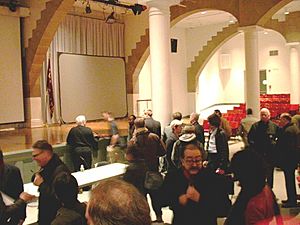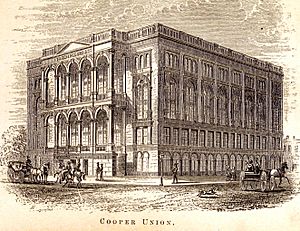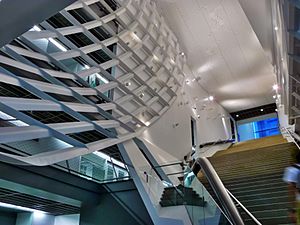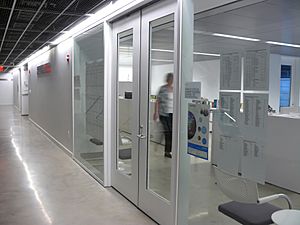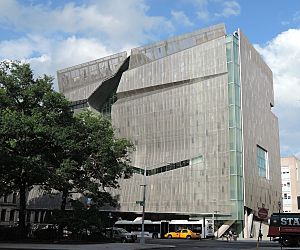Cooper Union facts for kids
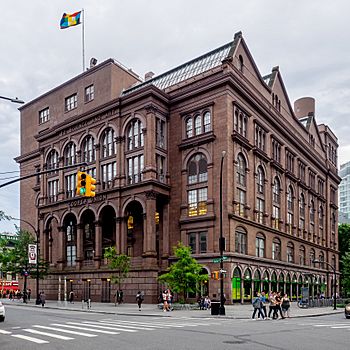
The Cooper Union's Foundation Building at Cooper Square and Astor Place in 2019
|
|
| Type | Private college |
|---|---|
| Established | 1859 |
| Accreditation | MSCHE |
| Endowment | $920 million (2021) |
| President | Malcolm King (interim) |
|
Academic staff
|
57 (full time) (2017/2018) |
| Students | 800–900 |
| Location |
Manhattan, New York City
,
New York
,
United States
|
| Campus | Urban |
| Colors | Maroon and Gold |
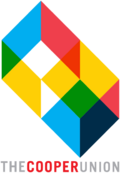 |
|
|
The Cooper Union
|
|
| Location | Cooper Square Manhattan, New York City |
| Built | 1858–59 |
| Architect | F.A. Peterson |
| NRHP reference No. | 66000540 |
| Significant dates | |
| Added to NRHP | October 15, 1966 |
| Designated NHL | July 4, 1961 |
The Cooper Union for the Advancement of Science and Art, often called Cooper Union, is a special private college. It is located in Manhattan, New York City, on Cooper Square. Peter Cooper started this school in 1859. He wanted to create a place where anyone could get a great education. This was true no matter their race, religion, gender, or how much money they had. He believed education should be "open and free to all."
The college has three main parts, called schools. These are the Irwin S. Chanin School of Architecture, the School of Art, and the Albert Nerken School of Engineering. Cooper Union offers degrees in architecture, fine arts (like painting and sculpture), and engineering. Students also take classes in humanities and social sciences.
For many years, Cooper Union gave a full scholarship to every student who was accepted. This meant they did not have to pay tuition. This practice changed in 2014, when they started offering half-tuition scholarships. As of 2024, almost half of the students still attend without paying tuition. In September 2024, the school announced that all students would not pay tuition for their senior year for the next four years.
Contents
History of Cooper Union
How Cooper Union Started
The Cooper Union was founded in 1859 by Peter Cooper. He was a very rich businessman in the United States. Peter Cooper himself had very little formal schooling. Even so, he became a successful inventor and businessman. He built America's first steam railroad engine. He also made a lot of money from a glue factory and an iron foundry.
Peter Cooper's big dream was to help talented young people. He wanted them to get the good education he never had. He believed this education should be "open and free to all." To make this happen, he used most of his wealth to start The Cooper Union. In the early days, the school did not allow discrimination based on a person's background.
Growing Over Time
The Cooper Union first offered night classes for adults. These classes taught subjects like applied sciences and architectural drawing. There were also day classes for women. These classes taught photography, telegraphy, and typing. The school also had a free reading room, which was the first in New York City.
Later, a four-year engineering college for men and some women was added. In 1883, a five-year program in chemistry was also started. A daytime engineering college opened in 1902, thanks to money from Andrew Carnegie. Many famous people took classes here, including Thomas Alva Edison.
Today, Cooper Union's free classes have grown into three main schools. These are the School of Art, the Irwin S. Chanin School of Architecture, and the Albert Nerken School of Engineering. Since 1859, many artists, architects, and engineers have studied here. Many of them became leaders in their fields.
The Cooper Hewitt, Smithsonian Design Museum was started in 1897. It was founded by Peter Cooper's granddaughters.
Important Buildings
The Foundation Building
The Cooper Union's Foundation Building is a brownstone building. It was designed by architect Fred A. Petersen. This building was the first in New York City to use strong iron beams for support. Peter Cooper himself invented and made these beams. The building was also the first in the world to be built with an elevator shaft. Peter Cooper believed elevators would be invented soon. He designed the shaft in a circle shape, expecting cylindrical elevators.
This building is very important. It was named a National Historic Landmark in 1961. It also became a New York City Landmark in 1965.
The Great Hall
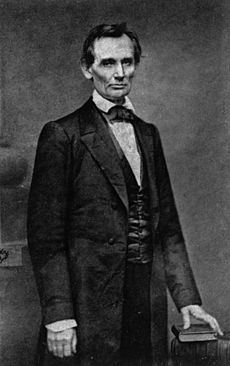
The Great Hall is in the basement of the Foundation Building. On February 27, 1860, Abraham Lincoln gave a famous speech here. About 1,500 people listened to him on a snowy night. This speech was printed in newspapers and pamphlets. It helped Lincoln gain support to become President. It is now known as the Cooper Union Address.
Many other important people have spoken in the Great Hall. These include Presidents Grant, Cleveland, Theodore Roosevelt, and Barack Obama. Civil rights leaders like Frederick Douglass and Susan B. Anthony also spoke there. The Great Hall is still used today for lectures and performances. It also hosts the school's annual Culture Show.
In late 2008, the Great Hall was closed for a big renovation. It reopened in March 2009.
Modern Changes
Cooper Union has schools for architecture, fine art, and engineering. These are the main degree programs. The Faculty of Humanities and Social Studies provides classes for all three programs.
In 2002, the school decided to build new facilities. They replaced an old engineering building and another building with a new one. This new building is called 41 Cooper Square.
41 Cooper Square
The new 41 Cooper Square building was designed by Thom Mayne. It is a modern and environmentally friendly building. It has nine floors above ground and two basements. The building has unique features like a tall Grand Atrium and many inside windows. It also has a four-story central staircase. These designs help create a social space for students and teachers.
The building's design lets in a lot of natural light. This helps save energy. In 2010, 41 Cooper Square became the first academic building in New York City to meet Platinum-level LEED standards. This means it is very energy efficient.
This new building mainly houses the School of Engineering and the School of Art. It has classrooms, labs, art studios, and faculty offices. The top floor is completely dedicated to art studios. The lowest basement has large machine shops and design labs. The first basement level has the Frederick P. Rose Auditorium. This is a lecture hall used for events.
Financial Support
Cooper Union gets a lot of its money from real estate. For example, the school owns the land under the Chrysler Building. As of 2009, Cooper Union received $7 million each year from this property. The school's endowment, which is like a savings fund, is over $600 million. This money helps support the scholarships and other school costs.
Tuition Changes
Around 2011, there were rumors that the school was having financial problems. In 2012, the college announced plans to start charging tuition for some graduate programs. They also planned to expand their continuing education programs that had fees.
In December 2012, some students protested against the idea of charging tuition for undergraduates. They occupied a part of the Foundation Building for a week. The college stopped its free tuition policy for undergraduates in 2014. However, it started offering scholarships based on financial need.
On May 8, 2013, students occupied the president's office to protest the end of free tuition. An agreement was reached on July 12, ending the occupation. A group called the Committee to Save Cooper Union (CSCU) worked to bring back the free tuition policy.
On September 1, 2015, the school and the CSCU reached an agreement. This agreement included plans to return to a sustainable, tuition-free policy. It also aimed for more transparency in the school's leadership. In January 2018, a committee recommended returning to full-tuition scholarships for undergraduates by the fall of 2028. In 2024, the school announced that about 83% of undergraduate tuition costs would be covered by scholarships for the 2024–2025 school year. They are still working towards their goal of 100% coverage by 2029.
Academics
Getting into Cooper Union is very competitive. Only about 12% of applicants are accepted across the three schools.
The Albert Nerken School of Engineering
The School of Engineering is named after Albert Nerken, a former student. It has about 550 students, making it the largest school. It offers Bachelor of Engineering (BE) degrees in different engineering fields. It also has a Bachelor of Science in Engineering (BSE) degree. Students can also study subjects like bioengineering or computer science.
The school has special facilities for learning and research. These include the Maurice Kanbar Center for Biomedical Engineering. There is also a Maker Space Lab for engineering, art, and architecture students.
Master's in Engineering
The School of Engineering also offers master's degrees. Students can study chemical, civil, electrical, or mechanical engineering. Cooper Union students can earn both a bachelor's and a master's degree in as little as five years.
The School of Art
The School of Art has about 200 students and 70 teachers. It offers a Bachelor of Fine Arts (BFA) degree. Students can also get a Certificate of Fine Arts. Students can exchange programs with other art colleges.
The Cooper Union Art program is known for being "generalist." This means students do not choose a specific major in art. Instead, they can take courses from any of the art departments. The program focuses on students' creativity and imagination.
Art Galleries
Cooper Union has galleries in public spaces and special rooms. These spaces show art by students, teachers, and guest artists. Popular galleries include the Great Hall lobby and the 41 Cooper Gallery. The 41 Cooper Gallery is a tall space for large art pieces.
There are also smaller exhibition spaces in both buildings. Larger spaces are used for art and architecture exhibitions. The Great Hall and the Rose Auditorium are used for video and digital art presentations.
Irwin S. Chanin School of Architecture
The Irwin S. Chanin School of Architecture offers a five-year program. It was started by John Hejduk. The school believes in "Social Contract" and sees education as a place that protects freedom. It also encourages open discussions and new ideas.
The teachers include famous architects and designers. Some former teachers include Peter Eisenman and Lebbeus Woods.
Master of Architecture II
A special master's degree program in architecture started in 2009. Students can focus on the theory, history, or technology of architecture. They can also study urban planning.
Athletics
Cooper Union has sports teams. Students can play basketball, volleyball, and soccer.
Notable Alumni
Many Cooper Union alumni have received important awards. These include a Nobel Prize in Physics and a Pritzker Prize for architecture. They have also won National Medal of Arts Awards and Guggenheim Fellowships. Since 2001, 40 alumni have been Fulbright Scholars.
Notable Faculty
Some notable teachers at Cooper Union include:
- Diana Agrest, architect
- Eleanor K. Baum, electrical engineer
- Peter Eisenman, architect
- William Germano, editor
- Hans Haacke, artist
- Lucy Raven, artist
See also
 In Spanish: Cooper Union para niños
In Spanish: Cooper Union para niños
- Presidents of Cooper Union
- Association of Independent Technological Universities


